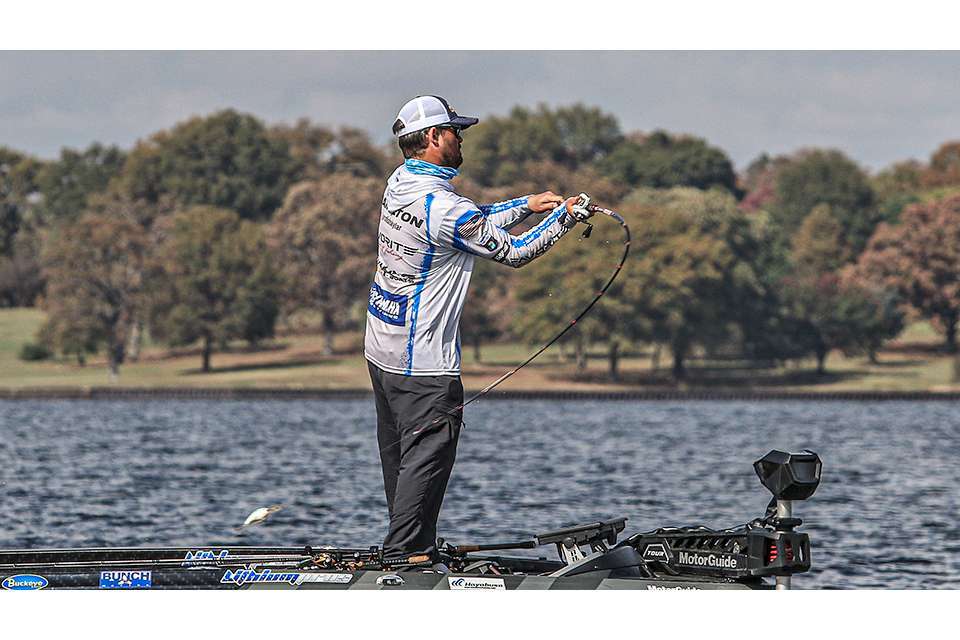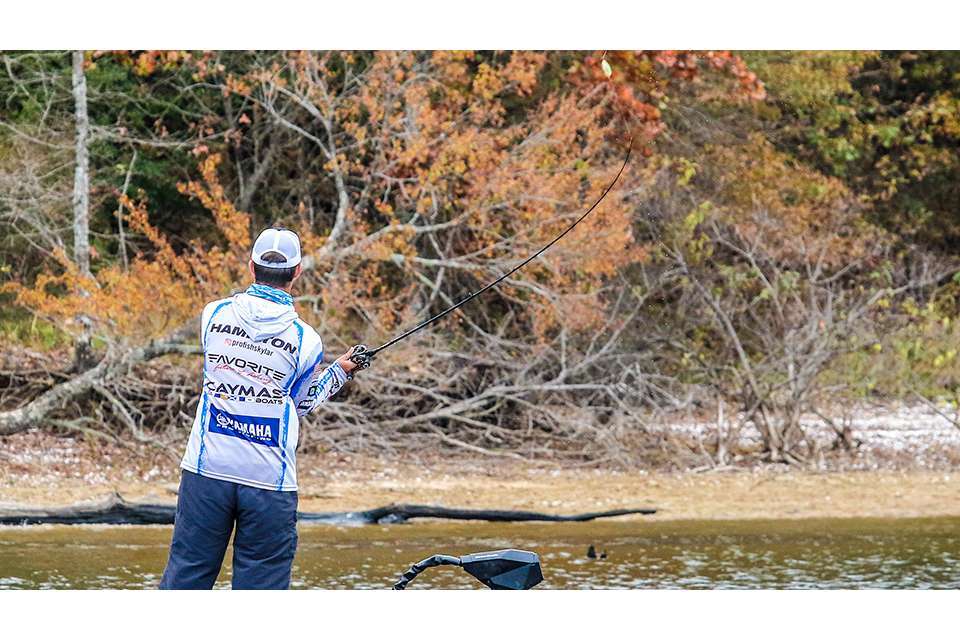
Nearly vertical rock walls are like elevators for bass, as the fish can easily rise and descend through the water column for feeding and/or comfort reasons without venturing far from their security zone. Calling this a major fall pattern, particularly in his East Tennessee home waters, Bassmaster Elite Skylar Hamilton holds bluffs in high regard.
“The good thing about bluffs is you can catch fish on them all year, fish even spawn on them,” Hamilton said. “They’re really good later in the fall and into winter they get really good, because the fish are coming out (of the creeks) to the deeper water for the wintertime patterns.
“You still have a lot of bait on those bluff walls, you still have a lot of bream. They like those steeper bluffs as we get closer to winter.”
Before sustained cold sets in, Hamilton finds the fish using the entire length of a bluff for feeding purposes. In any season, fish value the ability to pin prey against an unyielding boundary with immediate access to depth variances.
“Instead of having all these different directions for their food to go, they have one side completely blocked off,” Hamilton said. “That just takes away one escape route for the food they’re trying to eat.
Leverage the layout
With bluff walls generally comprising the vertical wall, a step and a tapering end, Hamilton usually starts on the latter. Noting that the bluff end varies from a slow, tapering point or a regular main lake point, Hamilton compares this part of the structure to an intersection.
“I usually start on the bluff end, because that often determines if it’s going to be a good one or not,” he said. “It’s a high-percentage area, like a bridge. If there’s a fish traveling from the creek to the bluff, or from the creek to the main lake, they’re probably going to go past that bluff end at some point.
“Bluff ends have fish going by constantly so it’s a good place to fish in the fall. That’s not to say you won’t go down the wall and catch some fish, but if you hit a good bluff end and catch a couple of fish, then that bluff will be a good one to fish. It just eliminates wasted time.”
Hamilton also notes that bluff walls lacking distinctly tapered ends are not be ignored: vertical walls upriver, for example. However, speaking specifically of fall patterns, those bluffs outside of creek mouths and their characteristic ends are money.
Attractive features
The presence of baitfish schools and/or bream is a must for consistent fish attraction, but Hamilton also likes to see a few more key features.
“One thing I really look for on bluffs is the type of rock. Is it a bigger rock, a slate rock or a step type of rock?” he said. “It’s going to be different, depending on where you are in the country, but the good thing about bluffs is they all usually have fish, regardless of the type of rock.
“There may be some that are better and you may have to figure out what they want to be on at that given time.”
Hamilton also likes to see additional hard targets like boat docks and laydowns. These fish magnets provide ambush spots, so they’re always worth a few shots.
Notably, fellow Elite Mike Huff lit up the Bassmaster LIVE coverage this year by catching a 7-pound, 13-ounce stud on the final morning of the Guaranteed Rate Bassmaster Elite at Chickamauga Lake.
“I always want to be near a major creek in the fall because a lot of fish are traveling to the creeks to eat and then coming out for the wintertime,” Hamilton said. “I’m not looking for a long straightaway bluff wall that’s away from everything; I want it to be near a population of fish.
“It might be a 2- to 3-mile stretch between two major creeks on the main lake. It could be near a choke point on the main lake where it narrows down and there’s a little more current.”
As far as conditions, warm, sunny days tend to bring the bait and the fish higher, while cold snaps push everyone deeper. Cloudy conditions might find the fish suspended.
Wind’s another plus, as the fish tend to chase those moving baits better on a windward bluff — especially a windblown bluff end. Using the reaction baits allows Hamilton to cover water faster to find fish.

The arsenal
Hamilton approaches bluffs with a trio of presentations that he feels will cover the playing field.
First is a 1/4- to 3/4-ounce Buckeye Lures Mop jig, a bait he can fish effectively on steep drop-offs for reaction bites or slowly crawl it down the side of a bluff wall. The living rubber skirt provides more flaring action than silicone, while brown/orange patterns best match crawfish. If he notices more bream forage, he’ll alter his colors accordingly.
“I like Zoom Big Salty Chunk or Berkley PowerBait MaxScent Chunk,” Hamilton said. “That makes it a big, bulky presentation that doesn’t necessarily have a lot of action to it, but it makes your jig glide and fall slower.”
Next up is a Rapala DT-6 to DT-16 crankbait matched to fish depth. Hamilton covers lots of water and rotates through the model selection to dial in the active depth. He’ll match his colors to water clarity and forage — baitfish patterns in early fall, then craw colors for late fall and into winter.
“You want to parallel the bluff; you don’t want to be way off and casting toward the bluff,” Hamilton said. “You want your boat almost bumping the side of the wall so you can make as many productive casts as possible.
“Those fish aren’t going to be very far out for the most part. You want to keep your bait in the area they’re swimming in.”
For a different reaction look, Hamilton’s third bluff choice is a 3/4-ounce white Buckeye Lures spinnerbait with tandem gold Colorado blades. In warmer water, he may switch to a willow/Colorado combo, but in most cases, the heavy thump of two Colorado’s emits maximum attraction, while slowing down the bait and keeping it in the right zone.
Rigging tip: Hamilton always uses a 3.8 Googan Baits swimbait trailer threaded onto his spinnerbait hook.
“You get a lot more bites because it slows the bait down and keeps it in a more natural position,” Hamilton said. “Without a trailer, the spinnerbait runs more head-first and your blades are going to be behind it. With a trailer, you’re keeping everything in a (streamlined profile) and that makes it easier to keep it in that strike zone.”
Hamilton’s parting advice: Pay attention to what’s below the surface. Scanning the bluff might reveal a “slide-in” — rocks or wood that slid off the face and settled into the water. Often, these random spots will offer key opportunities.





